Assessing Vulnerabilities in Line Length Parameterization and the Per-Unit-Length Paradigm for Phase Modulation and Figure-of-Merit Evaluation in 60 GHz Liquid Crystal Phase Shifters
Abstract
:1. Introduction
2. Materials and Methods
2.1. Vulnerabilities of Line Length Parameterized (LLP) on a Single Model
2.2. Discussions and Implications
2.3. Computational Time and Memory Usage of the Vulnerability-Free Approach
3. Vulnerabilities of Mainstream Per-Unit-Length (PUL) Paradigm
3.1. Limitation of PUL on Predicting Insertion Loss’s Frequency Response
3.2. Recommendations for Figure-of-Merit Prediction
4. Conclusions and Future Research Outlook
Author Contributions
Funding
Data Availability Statement
Conflicts of Interest
Abbreviations
| Nomenclatures | Abbreviations |
| Differential phase shift | DPS |
| Inverted microstrip line | IMS |
| Reconfigurable delay line phase shifter | RDLPS |
| Figure-of-merit | FoM |
| Liquid crystal | LC |
| Liquid crystal display | LCD |
| Coplanar waveguide | CPW |
| Shielded coplanar waveguide | SCPW |
| Line length parameterization | LLP |
| Radio frequency | RF |
| Microwave-wave | MW |
| Millimeter-wave | mmW |
| Megabyte | MB |
| Gigahertz | GHz |
| Terahertz | THz |
| Transverse electromagnetic | TEM |
| Scattering parameters | S parameters |
| Forward transmission coefficient | S21 |
| Forward reflection coefficient | S11 |
| Effective permittivity | eff |
| Three dimensional | 3D |
| Fifth-generation wireless | 5G |
| Sixth-generation wireless | 6G |
| High-frequency structure simulator | HFSS |
| Per-unit-length | PUL |
References
- White, J.F. Review of semiconductor microwave phase shifters. Proc. IEEE 1968, 56, 1924–1931. [Google Scholar] [CrossRef]
- Nagra, A.S.; York, R.A. Distributed analog phase shifters with low insertion loss. IEEE Trans. Microw. Theory Tech. 1999, 47, 1705–1711. [Google Scholar] [CrossRef]
- Iseghem, L.V.; Picavet, E.; Takabayashi, A.Y.; Edinger, P.; Khan, U.; Verheyen, P.; Quack, N.; Gylfason, K.B.; Buysser, K.D.; Beeckman, J. Low power optical phase shifter using liquid crystal actuation on a silicon photonics platform. Opt. Mater. Express 2022, 12, 2181–2198. [Google Scholar] [CrossRef]
- Anjos, E.V.P.; Schreurs, D.M.M.P.; Vandenbosch, G.A.E.; Geurts, M. A 14–50-GHz Phase Shifter with All-Pass Networks for 5G Mobile Applications. IEEE Trans. Microw. Theory Tech. 2020, 68, 762–774. [Google Scholar] [CrossRef]
- Grottke, T.; Hartmann, W.; Schuck, C.; Pernice, W.H. Optoelectromechanical phase shifter with low insertion loss and a 13π tuning range. Opt. Express 2021, 29, 5525–5537. [Google Scholar] [CrossRef]
- Stark, L. Microwave theory of phased-array antennas—A review. Proc. IEEE 1974, 62, 1661–1701. [Google Scholar] [CrossRef]
- Rao, J.B.L.; Patel, D.P.; Sengupta, L.C. Phased array antennas based on bulk phase shifting with ferroelectrics. Integr. Ferroelectr. 1998, 22, 307–316. [Google Scholar] [CrossRef]
- Scardelletti, M.C.; Ponchak, G.E.; Zaman, A.J.; Lee, R.Q. RF MEMS phase shifters and their application in phase array antennas. In Proceedings of the 2005 IEEE Annual Conference Wireless and Micrwave Technology, Clearwater Beach, FL, USA, 6–7 April 2005; pp. 191–194. [Google Scholar]
- Adomnitei, C.I.; Lesanu, C.E.; Done, A.; Yu, A.; Dimian, M.; Lavric, A. The Design and Implementation of a Phased Antenna Array System for LEO Satellite Communications. Sensors 2024, 24, 1915. [Google Scholar] [CrossRef]
- Abdalmalak, K.A.; Santamaría Botello, G.; Llorente-Romano, S.; Rivera-Lavado, A.; Flygare, J.; López Fernándezs, J.A.; Serna Puente, J.M.; García-Castillo, L.E.; Segovia-Vargas, D.; Pantaleev, M.; et al. Ultrawideband Conical Log-Spiral Circularly Polarized Feed for Radio Astronomy. IEEE Trans. Antennas Propag. 2020, 68, 1995–2007. [Google Scholar] [CrossRef]
- Rocca, P.; Mailloux, R.J.; Herd, J.S.; Massa, A. Recent Trends on Unconventional Phased Array Architectures for Communication, Sensing and Wireless Power Transmission. In Proceedings of the 2022 IEEE International Symposium on Antennas and Propagation and USNC-URSI Radio Science Meeting (AP-S/URSI), Denver, CO, USA, 10–15 July 2022; pp. 1610–1611. [Google Scholar]
- Eid, A.; Hester, J.G.D.; Tentzeris, M.M. 5G as a wireless power grid. Sci. Rep. 2021, 11, 636. [Google Scholar] [CrossRef]
- Kawamoto, H. The history of liquid-crystal display and its industry. In Proceedings of the 2012 Third IEEE History of Electro-Technology Conference (HISTELCON), Pavia, Italy, 5–7 September 2012; pp. 1–6. [Google Scholar]
- Weil, C.; Luessem, G.; Jakoby, R. Tunable inverted-microstrip phase shifter device using nematic liquid crystals. In Proceedings of the 2002 IEEE MTT-S International Microwave Symposium Digest, Seattle, WA, USA, 2–7 June 2002; pp. 367–371. [Google Scholar]
- Kuki, T.; Fujikake, H.; Nomoto, T. Microwave variable delay line using dual-frequency switching-mode liquid crystal. IEEE Trans. Microw. Theory Tech. 2002, 50, 2604–2609. [Google Scholar] [CrossRef]
- Muller, S.; Scheele, P.; Weil, C.; Wittek, M.; Hock, C.; Jakoby, R. Tunable passive phase shifter for microwave applications using highly anisotropic liquid crystals. In Proceedings of the 2004 IEEE MTT-S International Microwave Symposium Digest, Fort Worth, TX, USA, 6–11 June 2004; pp. 1153–1156. [Google Scholar]
- Yaghmaee, P.; Karabey, O.H.; Bates, B.; Fumeaux, C.; Jakoby, R. Electrically Tuned Microwave Devices Using Liquid Crystal Technology. Int. J. Antennas Propag. 2013, 2013, 824214. [Google Scholar] [CrossRef]
- Li, J. Challenges and Opportunities for Nematic Liquid Crystals in Radio Frequency and Beyond. Crystals 2022, 12, 632. [Google Scholar] [CrossRef]
- Quintana, D.P.; Aguirre, E.; Olariaga, E.; Kuznetsov, S.A.; Lapanik, V.I.; Sutormin, V.S.; Zyryanov, V.Y.; Marcotegui, J.A.; Beruete, M. Reconfigurable Millimeter-Wave Reflectarray Based on Low-Loss Liquid Crystals. IEEE Trans. Antennas Propag. 2024, 72, 531–541. [Google Scholar] [CrossRef]
- Oikonomou, V.K. Engineering and Materials: Editorial. Symmetry 2023, 15, 1902. [Google Scholar] [CrossRef]
- Ishihara, S.; Uto, S. Symmetry and Liquid Crystals. Symmetry 2023, 15, 691. [Google Scholar] [CrossRef]
- Koul, S.K.; Dey, S.; Poddar, A.K.; Rohde, U.L. Ka-band reliable and compact 3-bit true-time-delay phase shifter using MEMS single-pole-eight-throw switching networks. J. Micromech. Microeng. 2016, 26, 104002. [Google Scholar] [CrossRef]
- Neuder, R.; Späth, M.; Schüßler, M.; Sáez, A.J. Architecture for sub-100 ms liquid crystal reconfigurable intelligent surface based on defected delay lines. Commun. Eng. 2024, 3, 70. [Google Scholar] [CrossRef]
- Jakoby, R.; Gaebler, A.; Weickhmann, C. Microwave Liquid Crystal Enabling Technology for Electronically Steerable Antennas in SATCOM and 5G Millimeter-Wave Systems. Crystals 2020, 10, 514. [Google Scholar] [CrossRef]
- Li, J.; Li, H. Liquid Crystal-Filled 60 GHz Coaxially Structured Phase Shifter Design and Simulation with Enhanced Figure of Merit by Novel Permittivity-Dependent Impedance Matching. Electronics 2024, 13, 626. [Google Scholar] [CrossRef]
- Sahbani, F.; Hrizi, H.; Tentillier, N.; Gharsallah, A.; Legrand, C. High Birefringence Liquid Crystal for Tunable Microwave Phase Shifter: Design, Characterization and Performance Analysis. In Proceedings of the 2023 22nd Mediterranean Microwave Symposium (MMS), Sousse, Tunisia, 30 October–1 November 2023; pp. 1–4. [Google Scholar]
- Zografopoulos, D.C.; Ferraro, A.; Beccherelli, R. Liquid-crystal high-frequency microwave technology: Materials and Characterization. Adv. Mater. Technol. 2018, 4, 1800447. [Google Scholar] [CrossRef]
- Koperwas, K.; Adrjanowicz, K.; Grzybowski, A.; Paluch, M. The role of the dipole moment orientations in the crystallization tendency of the van der Waals liquids—Molecular dynamics simulations. Sci. Rep. 2020, 10, 283. [Google Scholar] [CrossRef] [PubMed]
- Li, J.; Li, H. Effective Dielectric Constant Benchmark of 60 GHz Liquid Crystal-Filled Coaxial Delay Line. In Proceedings of the 2024 IEEE International Conference on Computational Electromagnetics (ICCEM), Nanjing, China, 15–17 April 2024; pp. 1–3. [Google Scholar]
- White, J.F. Diode Phase Shifters for Array Antennas. IEEE Trans. Microw. Theory Techn 1974, 22, 658–674. [Google Scholar] [CrossRef]
- Li, J. Rethinking Liquid Crystal Tunable Phase Shifter Design with Inverted Microstrip Lines at 1–67 GHz by Dissipative Loss Analysis. Electronics 2023, 12, 421. [Google Scholar] [CrossRef]
- Massoni, E.; Bozzi, M.; Perregrini, L.; Tamburini, U.A.; Tomassoni, C. A novel class of high dielectric resonator filters in microstrip line technology. In Proceedings of the 2017 IEEE MTT-S International Microwave Workshop Series on Advanced Materials and Processes for RF and THz Applications (IMWS-AMP), Pavia, Italy, 20–22 September 2017; pp. 1–3. [Google Scholar]
- Abdulkarim, Y.I.; Deng, L.; Karaaslan, M.; Altıntaş, O.; Awl, H.N.; Muhammadsharif, F.F.; Liao, C.; Unal, E.; Luo, H. Novel Metamaterials-Based Hypersensitized Liquid Sensor Integrating Omega-Shaped Resonator with Microstrip Transmission Line. Sensors 2020, 20, 943. [Google Scholar] [CrossRef]
- Li, J.; Chu, D. Liquid Crystal-Based Enclosed Coplanar Waveguide Phase Shifter for 54–66 GHz Applications. Crystals 2019, 9, 650. [Google Scholar] [CrossRef]
- Li, J.; Xu, H.; Chu, D. Design of liquid crystal based coplanar waveguide tunable phase shifter with no floating electrodes for 60–90 GHz applications. In Proceedings of the 2016 46th European Microwave Conference (EuMC), London, UK, 4–6 October 2016; pp. 1047–1050. [Google Scholar]
- Nose, T.; Chien, L.C.; Catanescu, O.; Golvin, A.; Ito, Y.; Sasamori, T.; Isota, Y.; Ito, R.; Honma, M. Improved High-Frequency Performance of Microstrip-Line-Type Liquid Crystal Phase Shifter. Jpn. J. Appl. Phys. 2013, 52, 091701. [Google Scholar] [CrossRef]
- Neuder, R.; Wang, D.; Schüßler, M.; Jakoby, R.; Sáez, A.J. Compact Liquid Crystal-based Defective Ground Structure Phase Shifter for Reconfigurable Intelligent Surfaces. In Proceedings of the 2023 17th European Conference on Antennas and Propagation (EuCAP), Florence, Italy, 26–31 March 2023; pp. 1–5. [Google Scholar]
- Garbovskiy, Y.; Zagorodnii, V.; Krivosik, P.; Lovejoy, J.; Camley, R.E.; Celinski1, Z.; Glushchenko, A.; Dziaduszek, J.; Dąbrowski, R. Liquid crystal phase shifters at millimetre wave frequencies. J. Appl. Phys. 2012, 111, 054504. [Google Scholar] [CrossRef]
- Bilotti, F.; Barbuto, M.; Zarghani, Z.H.; Karamirad, M.; Longhi, M.; Monti, A.; Ramaccia, D.; Stefanini, L.; Toscano, A.; Vellucci, S. Reconfigurable intelligent surfaces as the key-enabling technology for smart electromagnetic environments. Adv. Phys. X 2024, 9, 2299543. [Google Scholar] [CrossRef]
- Anand, P.; Sharma, S.; Sood, D.; Tripathi, C.C. Design of compact reconfigurable switched line microstrip phase shifters for phased array antenna. In Proceedings of the 2012 1st International Conference on Emerging Technology Trends in Electronics, Communication & Networking, Surat, India, 19–21 December 2012; pp. 1–3. [Google Scholar]
- Antony, A.J.; Sudesh, A.A.; Mohamed, A.; Gopika, R.; Mitra, A.; Sarkar, D.; Saha, C. Design of a 360° Continuously Variable Phase Shifter using Improved Regression Algorithm for X-band Phased Array Applications. In Proceedings of the 2021 IEEE MTT-S International Microwave and RF Conference (IMARC), Kanpur, India, 17–19 December 2021; pp. 1–4. [Google Scholar]
- Zhang, X.; Daryoush, A.S. Full 360 degrees phase shifting of injection-locked oscillators. IEEE Microw. Wirel. Compon. Lett. 1993, 3, 14–16. [Google Scholar] [CrossRef]
- Li, J.; Li, H. Symmetry Implications of a 60 GHz Inverted Microstrip Line Phase Shifter with Nematic Liquid Crystals in Diverse Packaging Boundary Conditions. Symmetry 2024, 16, 798. [Google Scholar] [CrossRef]
- Lim, K.C.; Margerum, J.D.; Lackner, A.M. Liquid crystal millimeter wave electronic phase shifter. Appl. Phys. Lett. 1993, 62, 1065–1067. [Google Scholar] [CrossRef]
- Inan, A.S.; Osterberg, P.M. Calculating the per-unit-length circuit parameters of a coaxial transmission line using singularity functions. In Proceedings of the IEEE Antennas and Propagation Society Symposium, Monterey, CA, USA, 20–25 June 2004; pp. 2067–2070. [Google Scholar]
- Südekum, S.; Leone, M. Improved Per-Unit-Length Parameter Definition for Non-Uniform and Lossy Multiconductor Transmission Lines. In Proceedings of the 2018 International Symposium on Electromagnetic Compatibility (EMC EUROPE), Amsterdam, The Netherlands, 27–30 August 2018; pp. 1–6. [Google Scholar]
- Matsuki, M.; Matsushima, A. Efficient numerical method for computing per-unit-length impedance of transmission lines with lossy substrate. In Proceedings of the 2012 International Symposium on Antennas and Propagation (ISAP), Nagoya, Japan, 29 October–2 November 2012; pp. 963–966. [Google Scholar]
- Azadeh, S.S.; Merget, F.; García, S.R.; Mártir, A.M.; Driesch, N.V.D.; Müller, J.; Mantl, S.; Buca, D.; Witzens, J. Low Vπ Silicon photonics modulators with highly linear epitaxially grown phase shifters. Opt. Express 2015, 23, 23526–23550. [Google Scholar] [CrossRef] [PubMed]
- Maksimov, A.E.; Kuksenko, S.P. On the Features of Calculating per-Unit-Length Parameters and Characteristics of Multiconductor Transmission Lines. J. Commun. Technol. Electron. 2023, 68, 1412–1429. [Google Scholar] [CrossRef]
- Alam, B.; Cornaggia, F.; Alessandro, A.; Asquini, R. Design and analysis of high performance phase shifters on polymeric slot waveguides within liquid crystal cladding. Opt. Quant. Electron. 2022, 54, 800. [Google Scholar] [CrossRef]
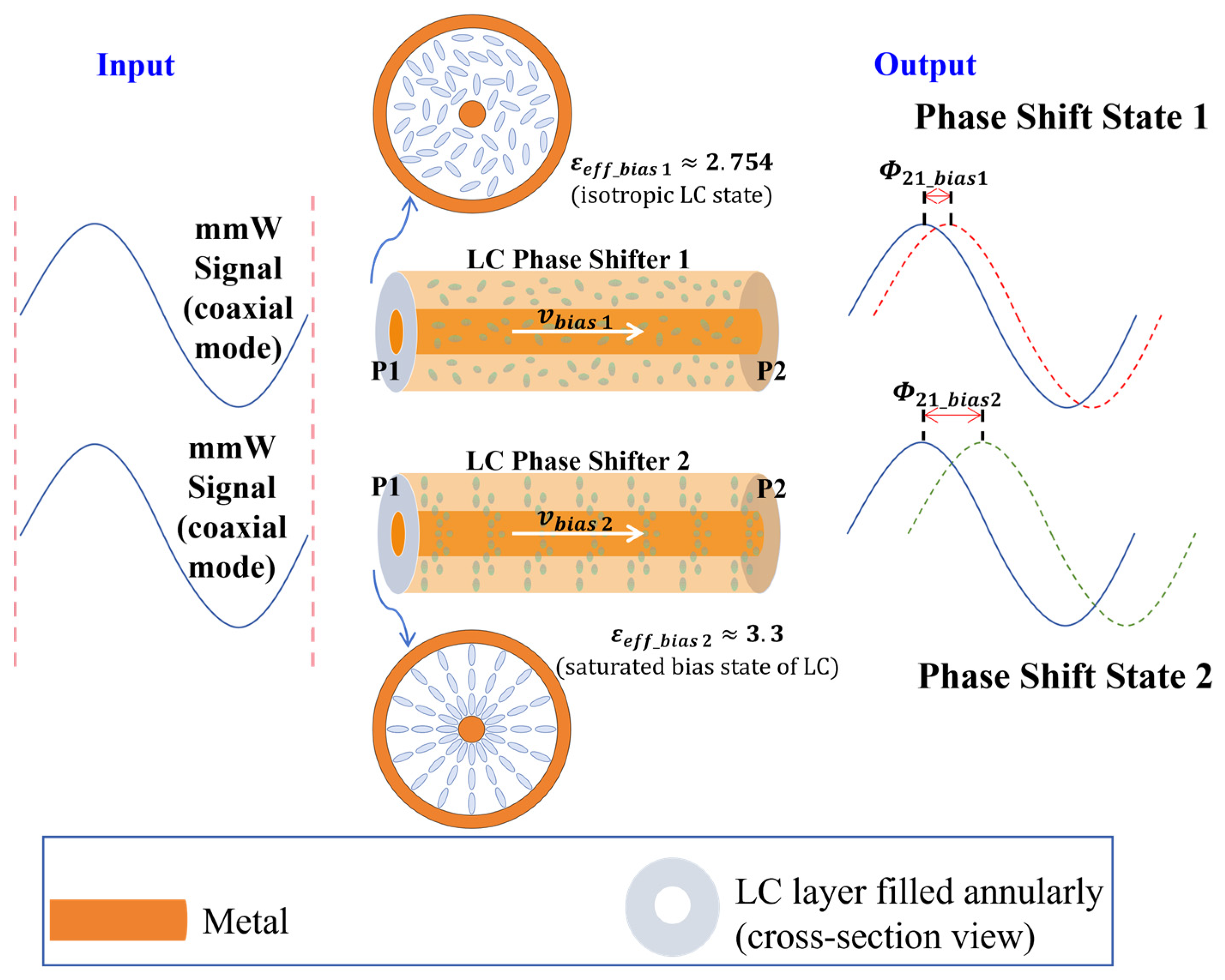
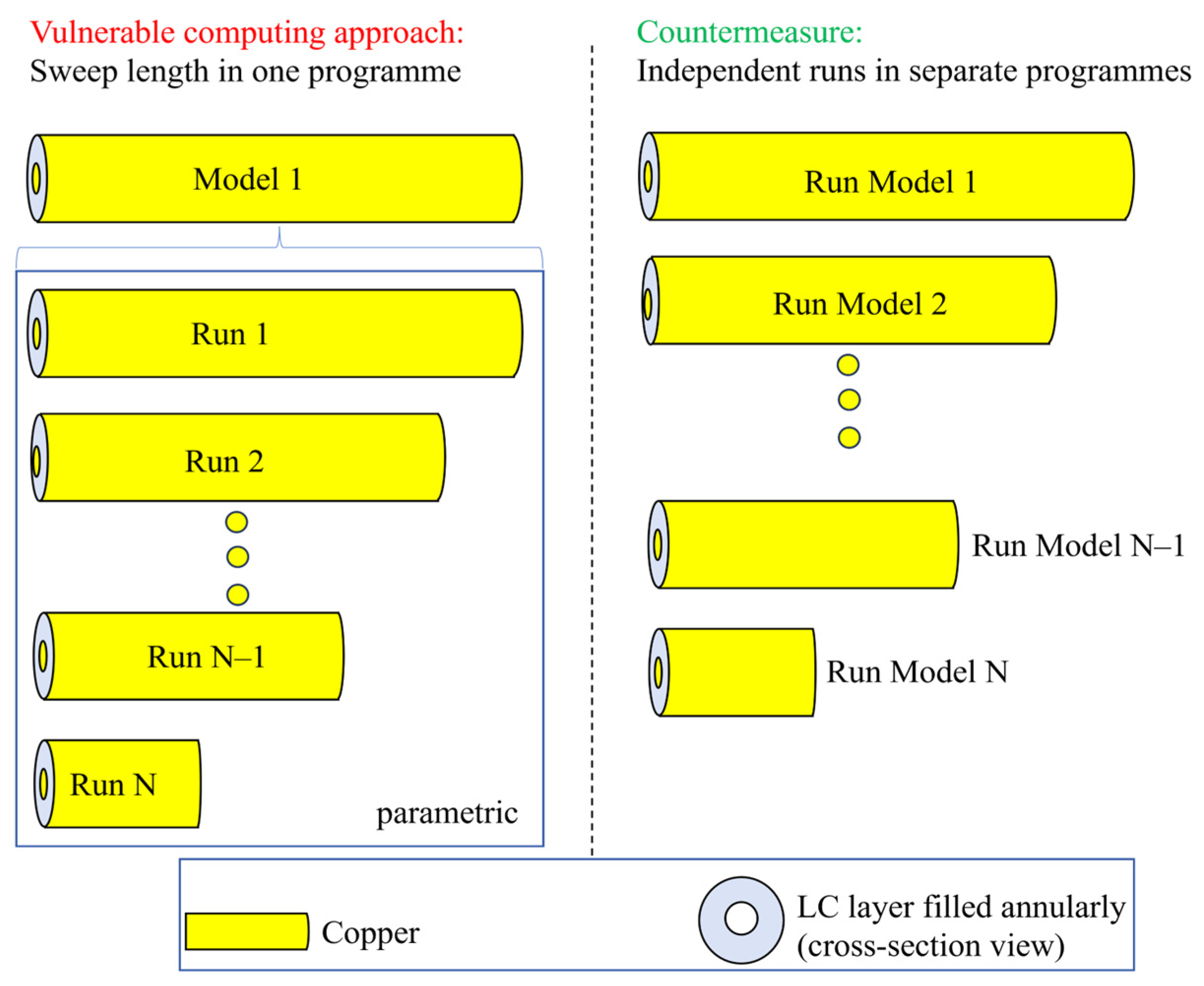
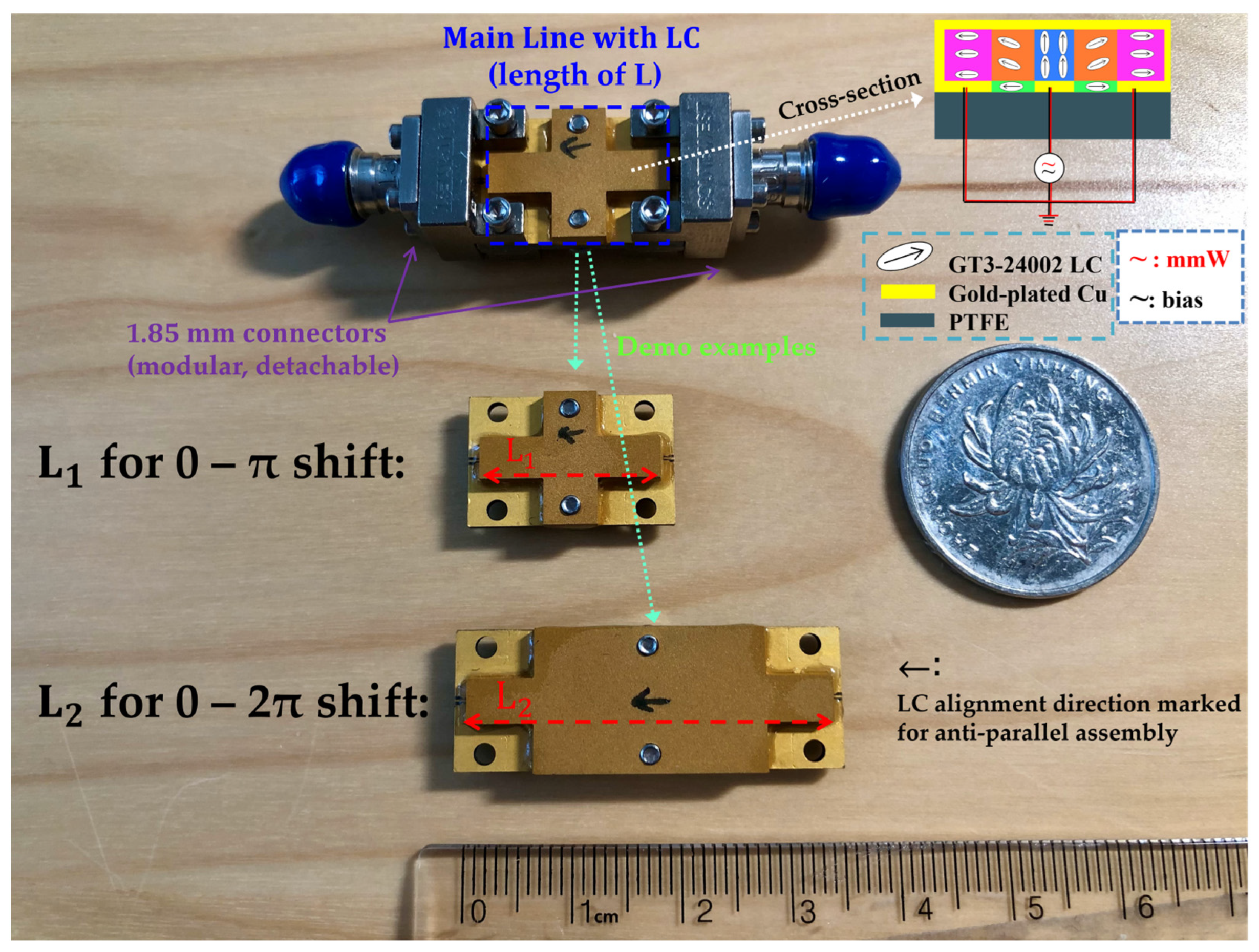
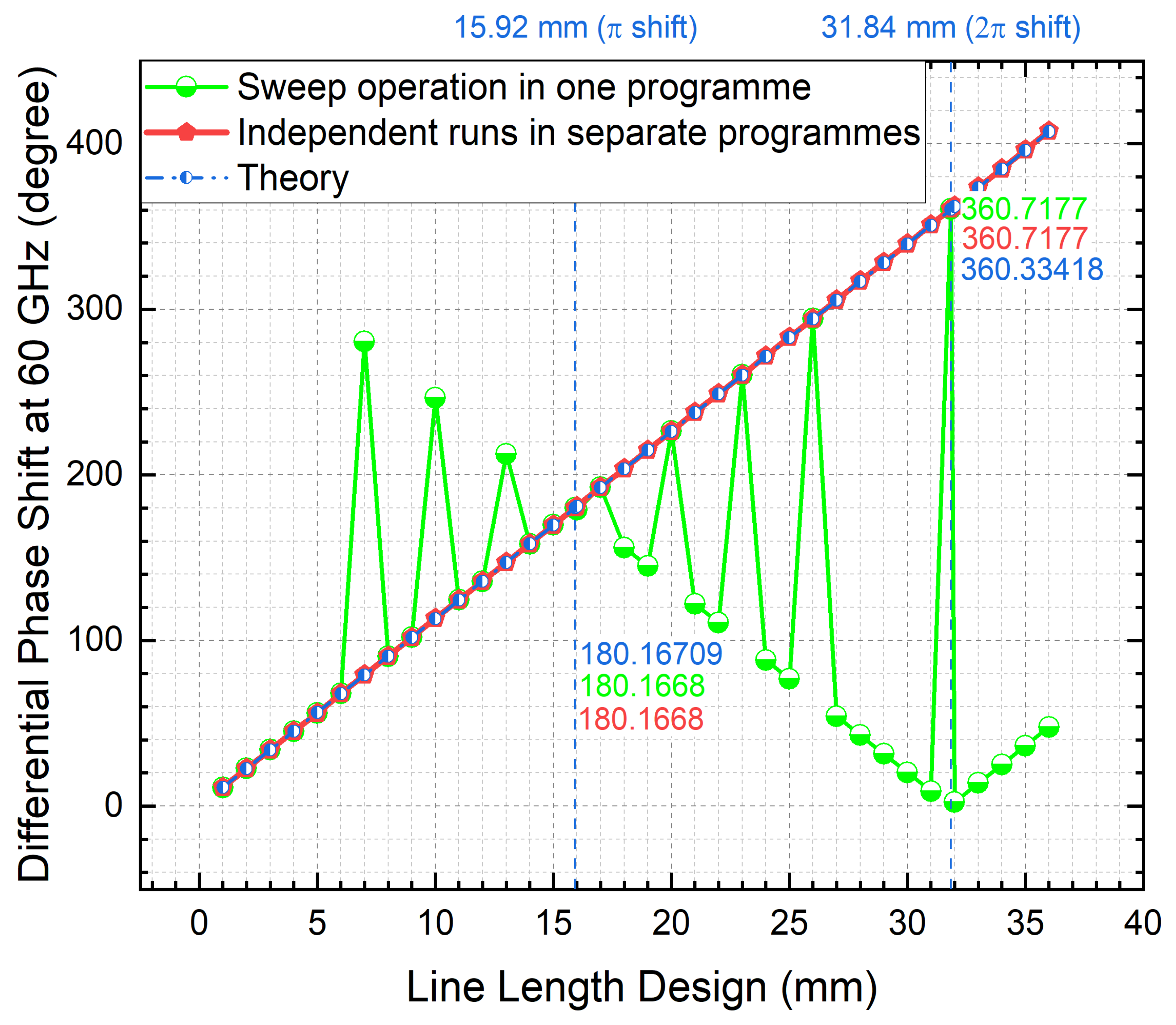
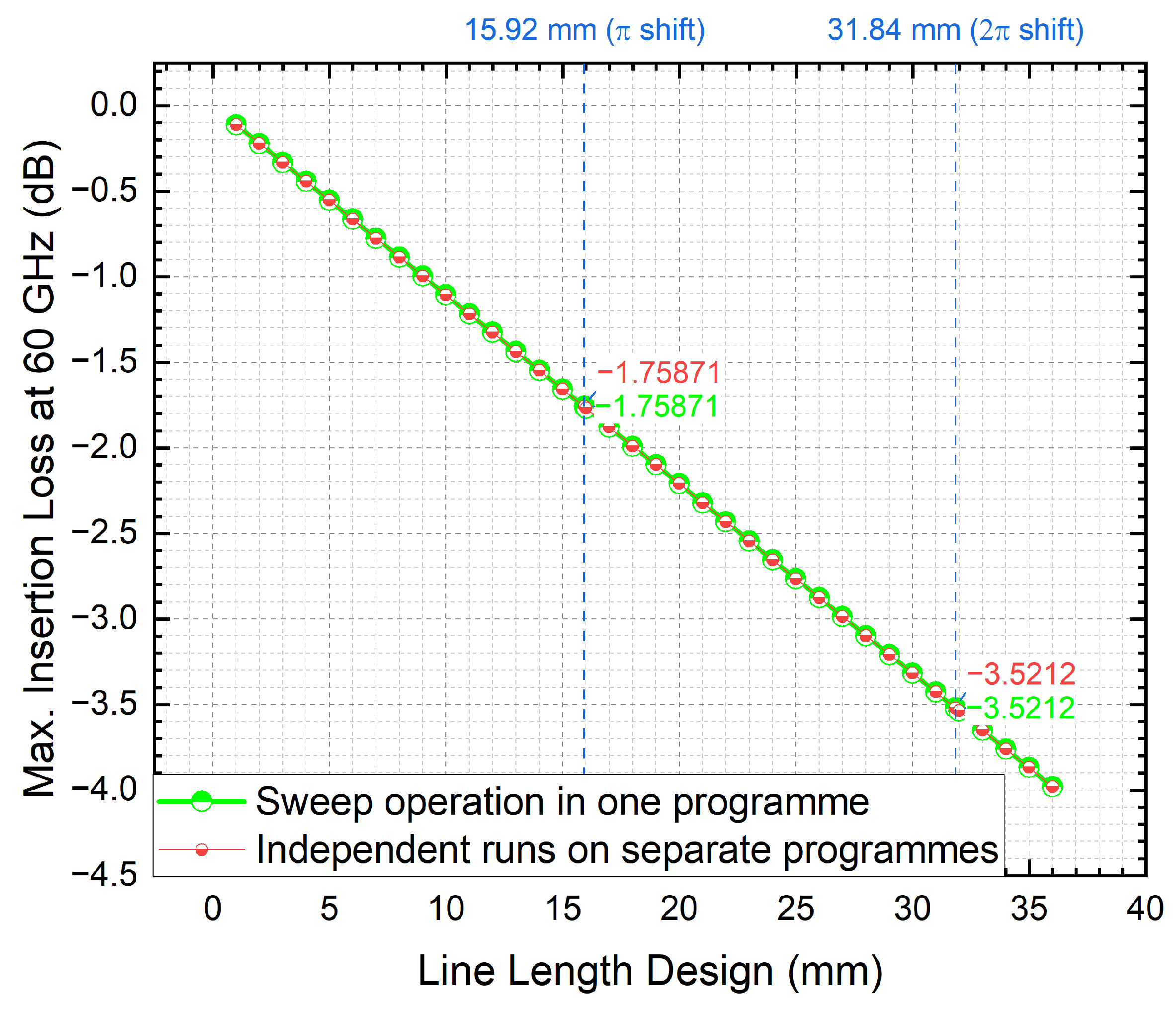
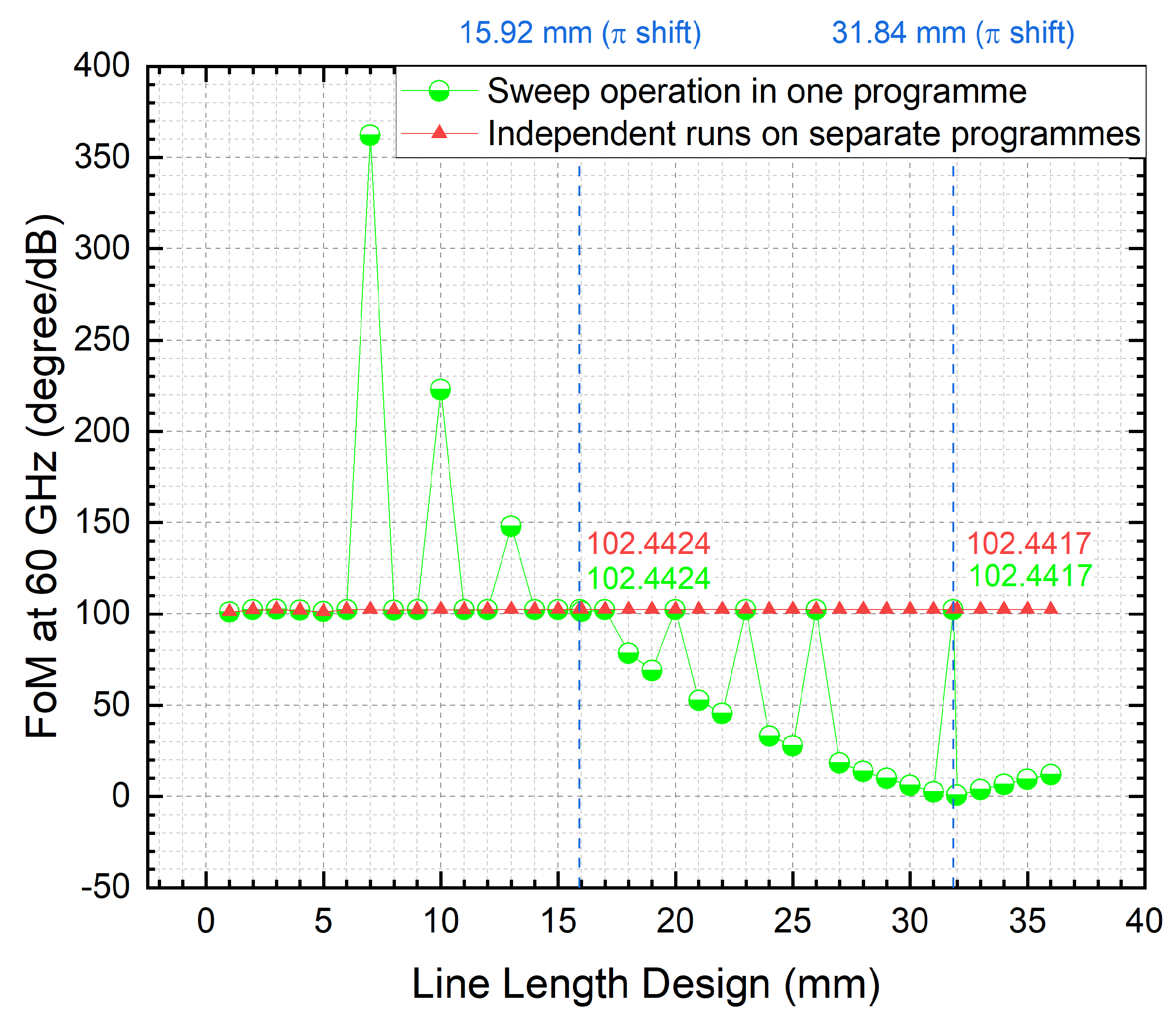
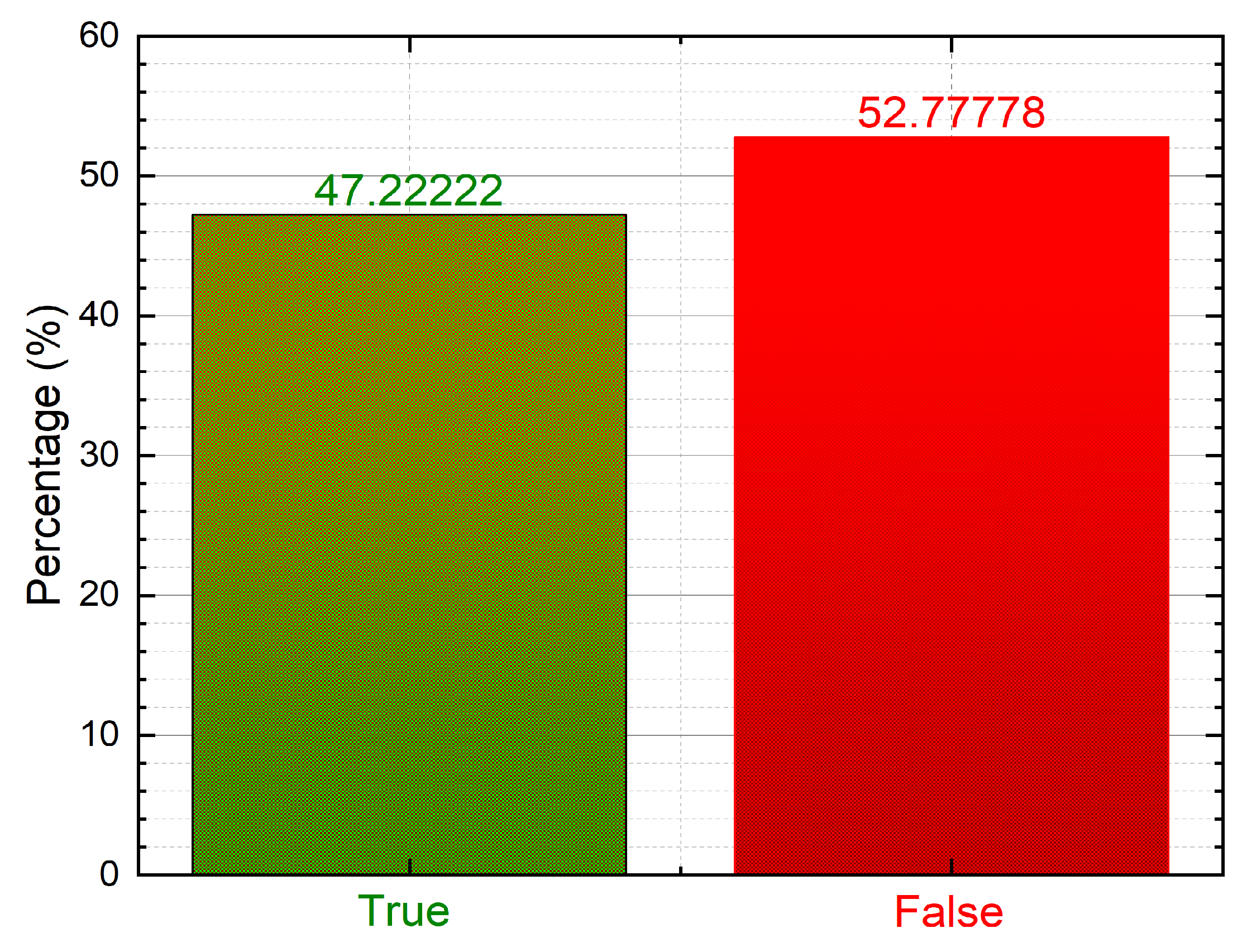
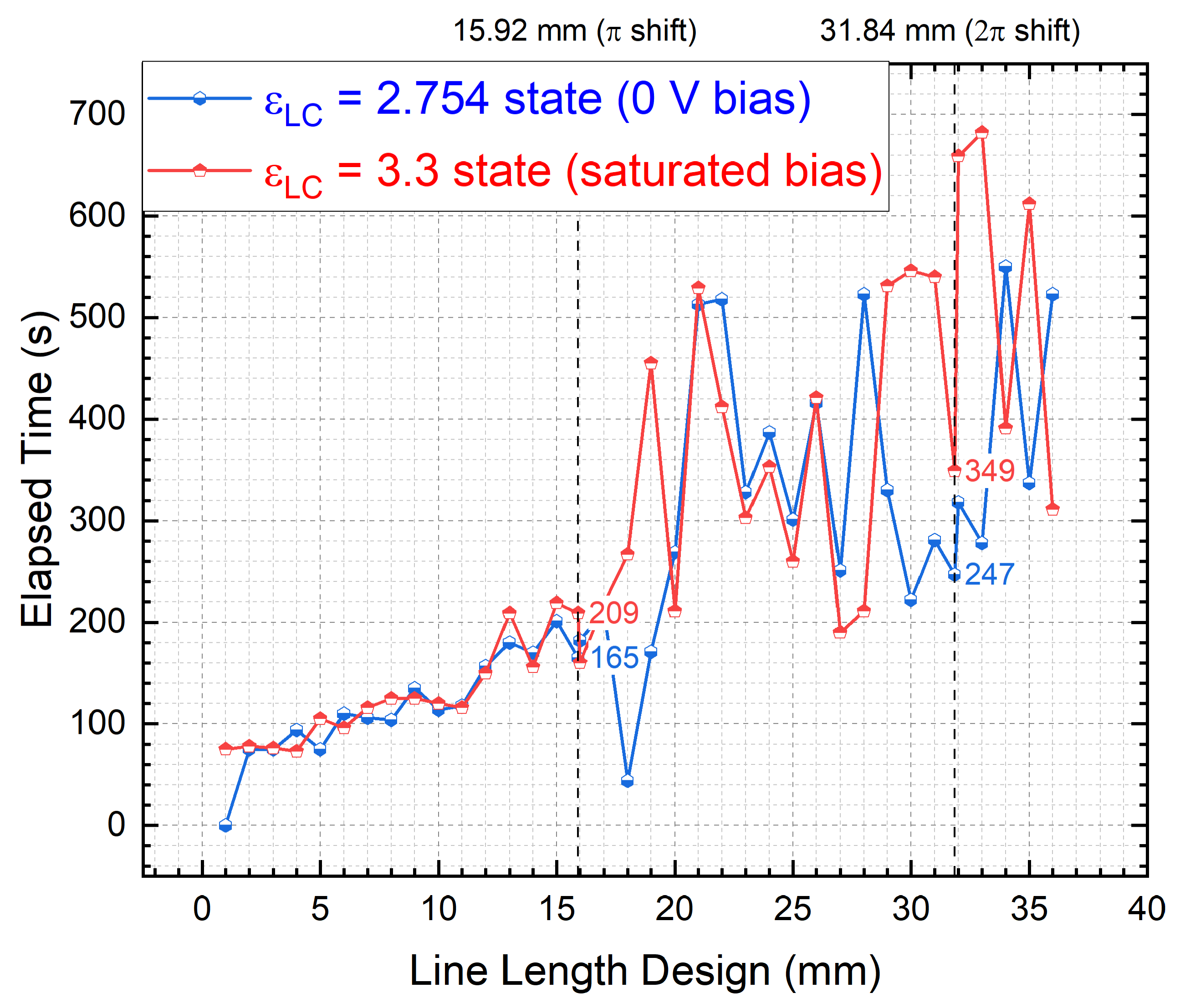
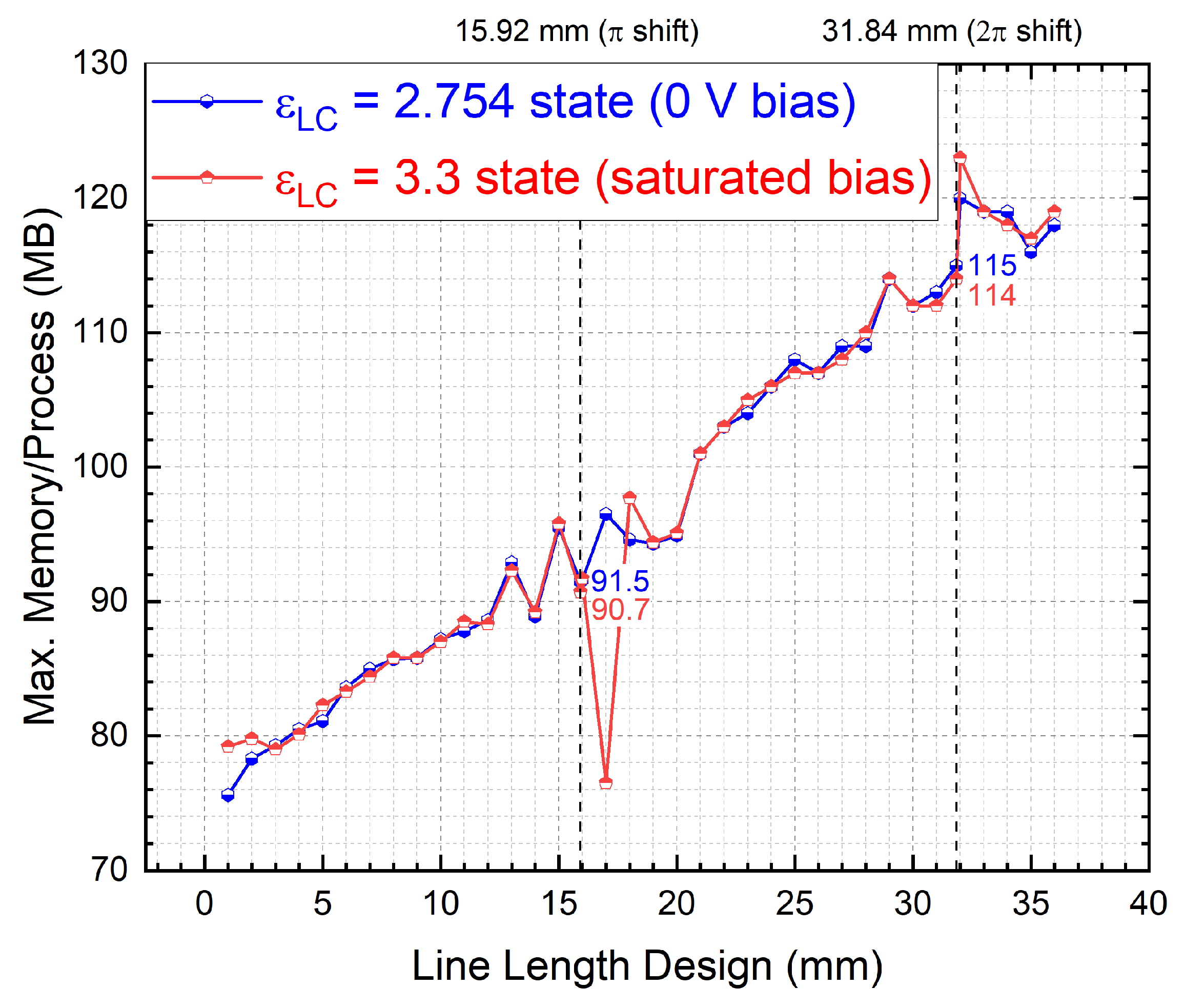


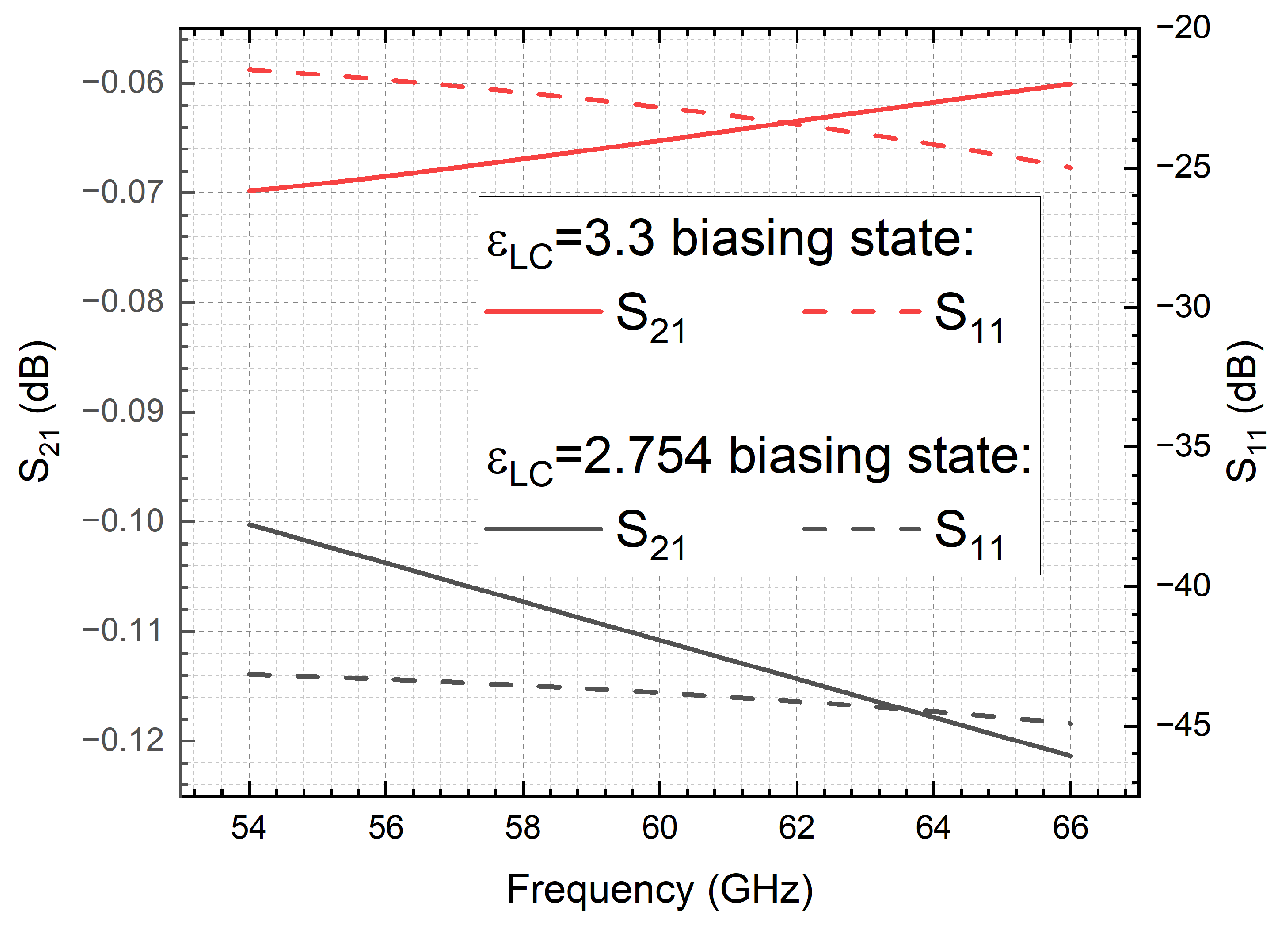
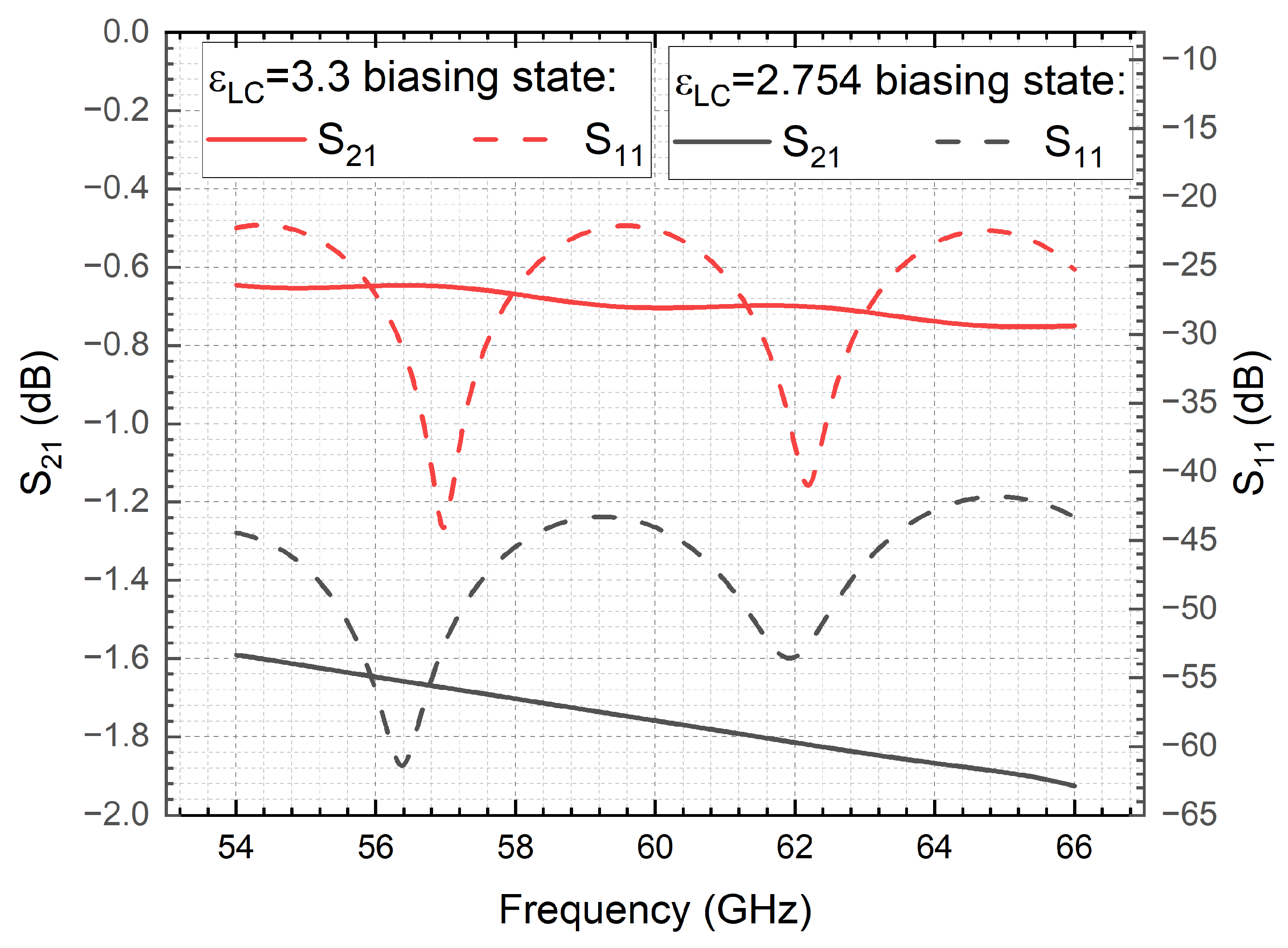
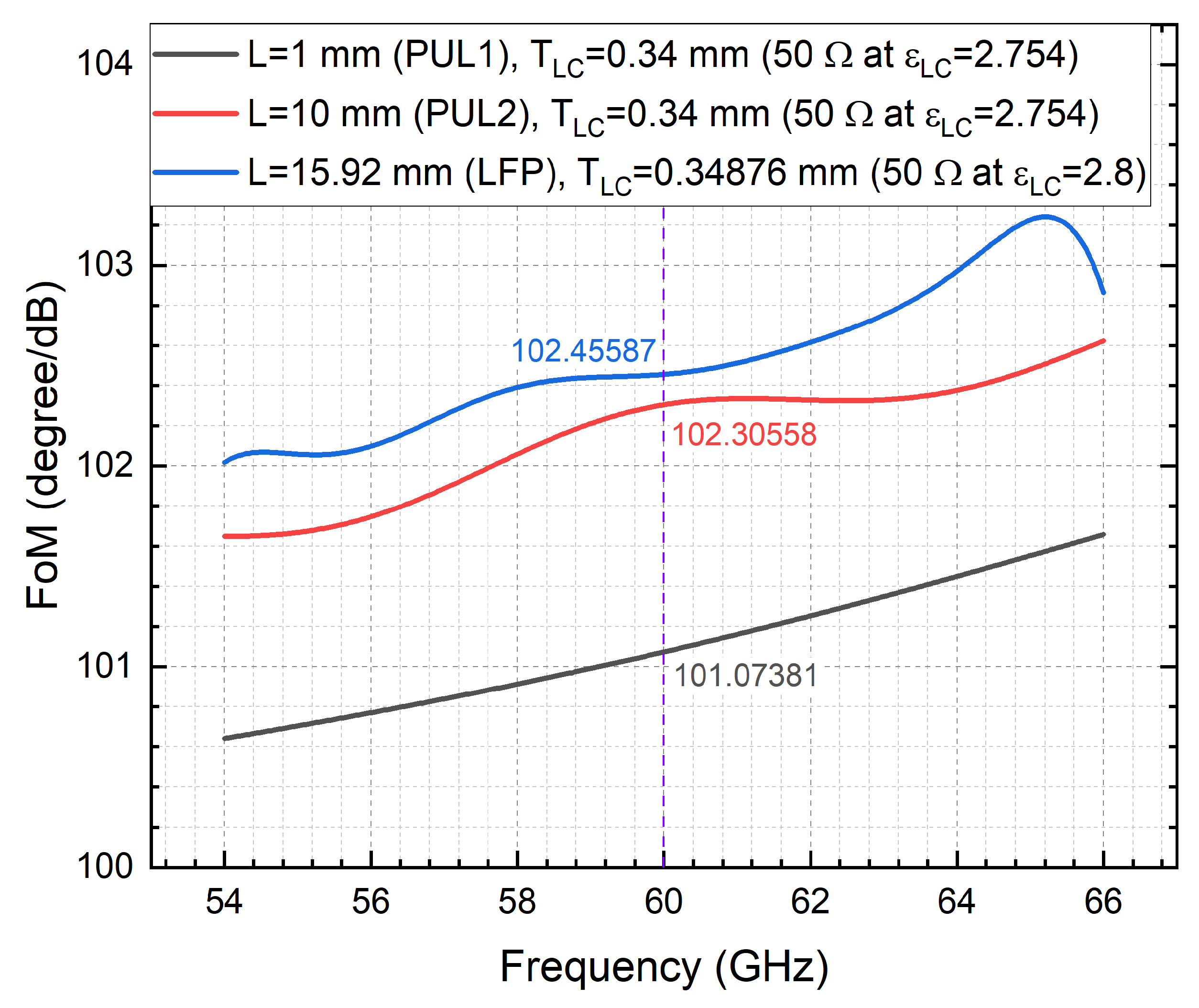
Disclaimer/Publisher’s Note: The statements, opinions and data contained in all publications are solely those of the individual author(s) and contributor(s) and not of MDPI and/or the editor(s). MDPI and/or the editor(s) disclaim responsibility for any injury to people or property resulting from any ideas, methods, instructions or products referred to in the content. |
© 2024 by the authors. Licensee MDPI, Basel, Switzerland. This article is an open access article distributed under the terms and conditions of the Creative Commons Attribution (CC BY) license (https://creativecommons.org/licenses/by/4.0/).
Share and Cite
Li, J.; Li, H. Assessing Vulnerabilities in Line Length Parameterization and the Per-Unit-Length Paradigm for Phase Modulation and Figure-of-Merit Evaluation in 60 GHz Liquid Crystal Phase Shifters. Symmetry 2024, 16, 1261. https://doi.org/10.3390/sym16101261
Li J, Li H. Assessing Vulnerabilities in Line Length Parameterization and the Per-Unit-Length Paradigm for Phase Modulation and Figure-of-Merit Evaluation in 60 GHz Liquid Crystal Phase Shifters. Symmetry. 2024; 16(10):1261. https://doi.org/10.3390/sym16101261
Chicago/Turabian StyleLi, Jinfeng, and Haorong Li. 2024. "Assessing Vulnerabilities in Line Length Parameterization and the Per-Unit-Length Paradigm for Phase Modulation and Figure-of-Merit Evaluation in 60 GHz Liquid Crystal Phase Shifters" Symmetry 16, no. 10: 1261. https://doi.org/10.3390/sym16101261





